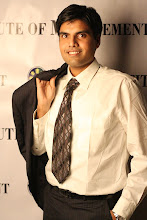Shahrukh has been my favourite actor since Daar and Bazigaar,Also my Dad's. I really respect his style and have loved all his movies.This post is a tribute to him and wishing him many more glorius years in bollywood.
SHAHRUKH KHAN (SRK) is the new superstar. Dilip Kumar, Rajesh Khanna and Amitabh Bachchan were the previous superstars of Bollywood. Popularly known as Badshah Khan or King Khan, Shahrukh Khan is celebrating his 44th birthday today i.e 2nd november 2008
From a Fauji and Circus boy, Shahrukh Khan has now become the superstar and also the first choice of millions of people across the world. In fact, it’s only Shahrukh who got the chance to ape superstar Dilip Kumar in Sanjay Leela Bhansali’s ‘Devdas’ and millennium star Amitabh Bachchan in Farhan Akhtar’s ‘Don’. On his 43rd birthday here is a brief account, Shahrukh Khan’s biography, mainly an account of his 15 year film career.
Born in Delhi, on November 2, 1965, in a Muslim family, Shahrukh Khan is a perfect example of a self made man. In fact, what he is today is totally due to his own effort and now he is one of the best actors that Indian cinema has ever seen. Shahrukh started his acting journey right from his college going days. Armed with an unfinished Masters Degree in Mass Communications from Jamia Millia Islamia, New Delhi and learning the nitty-gritties he took the plunge in the world of acting.
Shahrukh Khan’s performance was first noticed in the television serial ‘Fauji’, which was his small screen debut. But then nobody was expecting that the thin shy boy would become a superstar one day. In the next teleserial, ‘Circus’ Shahrukh played the role of an unconcerned son of a circus owner. Shahrukh’s Bollywood journey began with Raj Kanwar’s ‘Deewana’ (1992) and he was awarded the Filmfare Best newcomer award for the same film. From there till date Shahrukh Khan never looked back. In a period, success became synonymous with Shahrukh’s name.
Shahrukh Khan’s life history is quite interesting. Cinema lovers have accepted Shahrukh Khan in various kinds of roles particularly as the romantic boy. Most importantly in the initial stage of his career when he was trying to get a foothold in Hindi film industry, he accepted the negative roles. He played an obsessed lover in Yash Johar’s ‘Darr’, that challenging role provided him an instant recognition. The unique style of dialogue delivery "Ka...Ka.... Kaa.... Kiran" became very popoular during those days. ‘Baazigar’, ‘Ram Jaane’ and ‘Anjaam’ were other films in which Shahrukh played negative characters.
‘Darr’ opened the floodgates of success for Shahrukh and he made an entry into the Yash Chopra camp. Yash Raj’s ‘Dilwale Dulhaniya Le Jayenge’ (1995) was a roaring hit that got him the Filmfare Best Actor Award. The film made a record of running continuously over 500 weeks in Mumbai’s Maratha Mandir. ‘Dil to Pagal Hai’, ‘Mohabbatein’ and ‘Veer Zaara’ were other successful films under the Yash Raj banner and all praised the work of Shahrukh Khan’s performance in these films. Karan Johar’s ‘Kuch Kuch Hota Hai’, ‘Kabhi Khushi Kabhi Gham’, ‘Kal Ho Naa Ho’ and ‘Kabhi Alvida Naa Kehna’ were another feathers in his cap. Shahrukh’s other notable films include ‘Raju Ban Gaya Gentleman’, ‘Kabhi Haan Kabhi Naa’, ‘Pardes’, ‘Yes Boss’, ‘Dil Se’ and ‘Josh’.
With a wish to enact dual responsibility, Shahrukh Khan launched his own production company ‘Dreamz Unlimited’ in collaboration with actress Juhi Chawla and director Aziz Mirza. ‘Dreamz Unlimited’ made remarkable films ‘Phir Bhi Dil Hai Hindustani’ and ‘Chalte Chalte’. In the year 2004, Shahrukh launched another banner called ‘Red Chillies Entertainment’ and made ‘Main Hoon Naa’ that become a big hit. SRK’s ‘Om Shanti Om’ is another film from ‘Red Chillies Entertainment’, which is set to release on November 9. Om Shanti Om’s success can be his best birthday gift.
Shahrukh Khan has won above fifty national and international awards. In 2004 he was conferred with prestigious ’Padma Shri’ Award for his valuable contribution to Indian art and culture. Shahrukh is catching up with veteran actor Dilip Kumar in bagging the maximum number of Filmfare Best Actor awards. He has won six Filmfare awards in the best actor category till now.
His forth coming movies Billo Barber and Rab ne Bana Jodi are supposed to be good.
Reference: Merinews
Read more...








